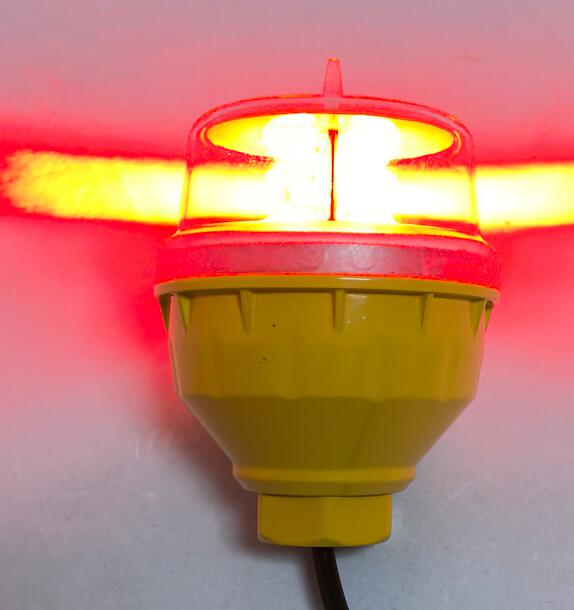Posted: 2025-06-12
In the complex matrix of aviation safety, every component has its role. While advanced radar systems and precision navigation dominate the spotlight, one understated yet indispensable element quietly ensures safety from the ground up—the CL 810 obstruction light. Specifically engineered for low-intensity, night-time visibility, the CL 810 obstruction light is a compact but powerful tool used to mark obstacles that could pose a risk to aircraft operating at lower altitudes.
What Is a CL 810 Obstruction Light?
The CL 810 obstruction light is a steady-burning, red, low-intensity warning light used to indicate the presence of fixed obstacles such as towers, poles, and buildings under a specific height threshold—typically 200 feet above ground level. It conforms to industry safety regulations and is widely used in aviation and telecommunications sectors to improve navigational awareness, particularly during night or low-visibility conditions.
Though compact and often unnoticeable by ground observers, the CL 810 obstruction light is a silent guardian that alerts pilots to potential hazards, preventing collisions and contributing to a safer airspace.

Key Applications of the CL 810 Obstruction Light
The versatility of the CL 810 obstruction light allows it to be used in a broad range of settings:
Telecommunication and Radio Towers: Tall towers for cellular, radio, and data transmission are commonly marked with CL 810 lights to ensure their visibility to passing aircraft.
Wind Turbines: In the expanding field of renewable energy, wind turbines are increasingly marked with CL 810 lights, especially in areas with low population density.
Industrial Chimneys: Factories and power generation facilities use these lights on smokestacks to comply with airspace safety requirements.
Construction Cranes: Temporary but tall construction structures also benefit from CL 810 lighting, particularly when located near airfields or flight routes.
Mid-Rise Urban Structures: Some buildings, especially in cities located near airports, integrate CL 810 obstruction lights to improve compliance with aviation safety regulations.
| CL 810 Obstruction Light |
Characteristics and Advantages
The CL 810 obstruction light offers a series of benefits that make it a preferred solution for marking low-height structures:
Steady Red Illumination: It provides a consistent red light that serves as a universal visual warning signal for pilots, particularly during approach and departure phases.
LED Technology: Modern CL 810 models employ energy-efficient LEDs that deliver long operational life and minimal maintenance needs.
Durable Housing: These lights are built to withstand exposure to harsh weather conditions, including high winds, moisture, and extreme temperatures.
Photocell Integration: Many versions include built-in sensors to automatically activate the light at dusk and deactivate it at dawn, optimizing energy use.
Low Power Demand: Their efficiency makes them suitable for remote or solar-powered systems, often used where grid power is unavailable or unreliable.
Role in Low-Altitude Flight Safety
Low-altitude flights—whether by helicopters, private aircraft, or emergency services—face greater risks from ground-based obstacles. The CL 810 obstruction light provides essential visual cues that help pilots avoid contact with fixed structures that may not be shown clearly on instruments or maps.
During night operations or when weather reduces visibility, these lights become even more critical. They serve as static, glowing signposts that guide aircraft safely through potentially congested or risky airspace near human development.
Compliance and Standards
To be classified as a CL 810 obstruction light, the unit must meet specific regulatory guidelines and technical performance standards:
Candela Output: The light must maintain a minimum luminous intensity over prescribed angles, typically around 32.5 candelas.
Color Specification: The emitted red light must fall within FAA or ICAO-approved chromaticity ranges to ensure consistency and reliability.
Operational Testing: CL 810 units undergo vibration, temperature, and humidity testing to confirm performance in all environmental conditions.
Mounting Compatibility: Lights must be easily integrated into new or existing structures, with adaptable mounting options to fit towers, poles, or mast heads.
Approved models carry certifications verifying their performance and safety, and are accepted in regulated airspace zones worldwide.
Smart Features and System Integration
While the CL 810 obstruction light is often praised for its simplicity, modern developments have added layers of functionality. These include:
Remote Monitoring: Some models support telemetry systems that notify operators of lamp status, failures, or deviations in performance.
Integration with Hybrid Systems: The CL 810 can function in tandem with medium-intensity lighting such as red flashing beacons. In these cases, the CL 810 operates as a base-level light, enhancing visibility at lower elevations.
Smart Grid Compatibility: Lights integrated into smart infrastructure can be synchronized with grid systems, enabling centralized control and automated diagnostics.
Environmental and Operational Considerations
As lighting technology evolves, so too does the emphasis on environmental responsibility. CL 810 lights using LEDs reduce energy consumption and produce less waste through their long lifespan. Additionally, these lights are designed to minimize light pollution, a growing concern in both urban and rural settings.
Their low-profile design and low-intensity output make them suitable for installation in environmentally sensitive areas, where wildlife and dark-sky preservation are priorities. Unlike high-intensity systems, CL 810 lights offer compliance without excessive brightness or ecological disruption.
Maintenance and Reliability
With fewer moving parts and efficient solid-state construction, LED-based CL 810 lights require minimal maintenance. Maintenance schedules are often driven by compliance checks rather than performance failures, making them cost-effective and operationally dependable.
Field-replaceable components and modular assembly allow for quick servicing, reducing downtime and ensuring continuous operation—especially critical in safety-sensitive environments.
The CL 810 obstruction light is a quiet but vital contributor to aviation safety. Its ability to mark low-level structures with reliable, efficient, and environmentally friendly lighting makes it an essential asset in both urban and remote locations. Whether used on communication towers or wind turbines, this humble light plays a strategic role in guiding aircraft safely through the skies.
As infrastructure continues to expand vertically and aviation traffic increases, the demand for effective obstruction marking solutions will only grow. The CL 810 obstruction light, with its balance of simplicity and modern capability, stands ready to meet that challenge—providing safety without spectacle, and reliability without compromise.